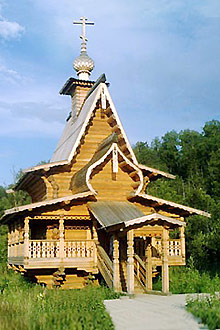 |
 Not far from the Trinity Monastery at Sergiev Posad lies the Abramtsevo estate, an intellectual and artistic center that played a doubly significant role in the development of Russian culture in the 19th Century.
Not far from the Trinity Monastery at Sergiev Posad lies the Abramtsevo estate, an intellectual and artistic center that played a doubly significant role in the development of Russian culture in the 19th Century.
Abramtsevo first came to prominence in 1843, when the estate was bought by Sergei Aksakov, a writer famous for his semi-autobiographical tales of aristocratic Russian life and treatises on country pursuits. He was an ardent Slavophile, who called for the rejection of European influences on Russian life and letters. Among his friends and supporters were Ivan Turgenev and Nikolai Gogol, both of whom were frequent guests at Abramtsevo. Gogol even wrote a significant part of Dead Souls here. Aksakov's sons, Ivan and Konstantin, continued their father's work as writers, Slavophiles and masters of Abramtsevo. When Ivan died in 1870, the estate was bought by Savva Mamontov, heir to a railroad fortune and one of the most significant figures in the development of Russian national art.
As a young man, Mamontov had shown a keen interest in and considerable talent for the dramatic and visual arts. Although his father frowned on such activities and urged his son to concentrate on the family business, Mamontov, while traveling in Italy, found the time to cultivate the friendship of a number of young Russian artists who were studying there and felt oppressed by the insistence on following Western European influences that dominated their education. When he returned to Russia, he established an artists' colony at Abramtsevo, and urged his friends to return to Moscow and pursue there interests at his expense. The group that gathered around him included Ilya Repin, Valentin Serov, Mikhail Vrubel, and the Vasnetsov brothers, Viktor and Apollinarius. All these artists have large bodies of work displayed in the Tretyakov Gallery, and Abramtsevo is the ideal destination for those intrigued by the little-known (outside Russia and specialist circles) world of 19th Century Russian art.
This extraordinary concentration of talent led to the transformation of Abramtsevo. Not only did these celebrated artists work here, producing a number of images of the estate and its buildings, they also left their permanent mark by collaborating on a number of building projects in traditional Russian styles, the culmination of which was the Church of the Saviour Not Made by Human Hand. This tiny church, based on designs from medieval Novgorod, has a wealth of artistic detail, including icons by Repin and Michael Nesterov, a mosaic floor by Viktor Vasnetsov, and Vrubel's tiled stove.
Other notable features of the estate are the Museum of Folk Art, the exhibits for which were collected by the colony's residents in various trips across Russia, and used as inspiration for the acclaimed ceramics that were produced here. There is also the House on Chicken Legs, designed for the colony's children, and based on the witch's house in the famous Russian fairytale Baba Yaga.
The main house, which was supposedly used by Chekhov as a model for the setting of The Cherry Orchard, is unimpressive from the exterior. However, there are rich interiors, half of them, preserved from Aksakov's time, in the French Empire style, and half showing Mamontov's taste for Neo-Russian and Style Moderne.
Abramtsevo continued to be used as an artists' retreat right through the 20th Century, and there is still a School of Applied Arts operating on the estate to date. Works by Soviet artists who worked at Abramtsevo are collected in a large white building opposite the mansion. Nothing in there compares, however, with the work produced by what came to be known as 'The Abramtsevo Group' in the 19th Century. Above all, the estate is a testament to the significance of Mamontov's patronage and support for Russian culture. Aside from his work in the visual arts, he was also instrumental in the establishment of Russian national opera. A trained singer himself, he established the Private Opera, first at Abramtsevo and then in Moscow, which show cased works by Mussorgsky and Rimsky-Korsakov, and the voice of the great Shalyapin. Even the lowly matryoshka doll was first produced in the Children's Education Workshop at Abramtsevo.
Getting there: Abramtsevo is on the same train line as Sergiev Posad (from Yaroslavl Station, Komsomolskaya Metro Station), although not all trains stop there. From Abramtsevo Station, it's a pleasant but fairly long walk through the woods to get to the estate.
Opening hours: Wednesday to Sunday, 10:00 to 17:00.
|
 |

 Not far from the Trinity Monastery at Sergiev Posad lies the Abramtsevo estate, an intellectual and artistic center that played a doubly significant role in the development of Russian culture in the 19th Century.
Not far from the Trinity Monastery at Sergiev Posad lies the Abramtsevo estate, an intellectual and artistic center that played a doubly significant role in the development of Russian culture in the 19th Century.